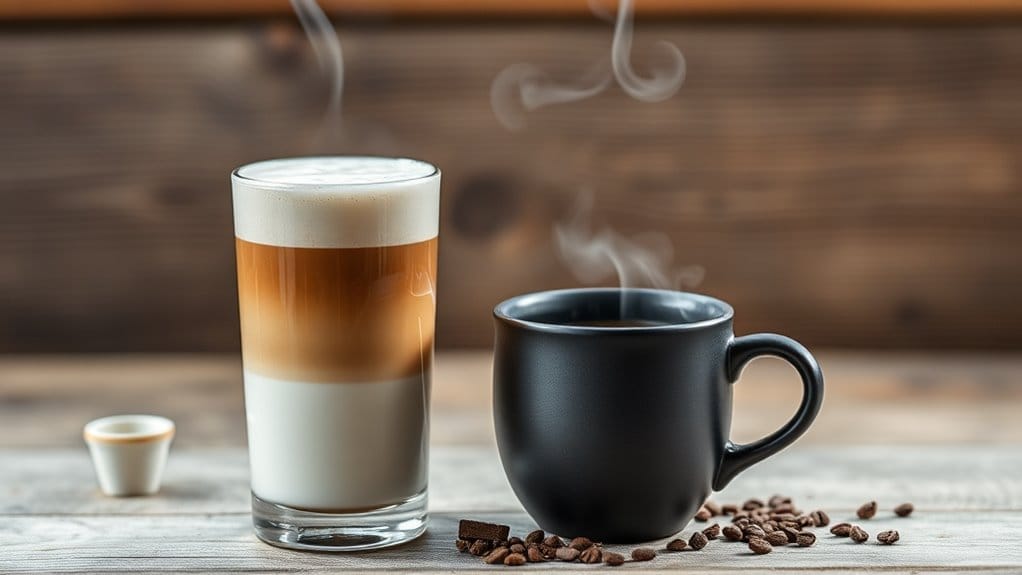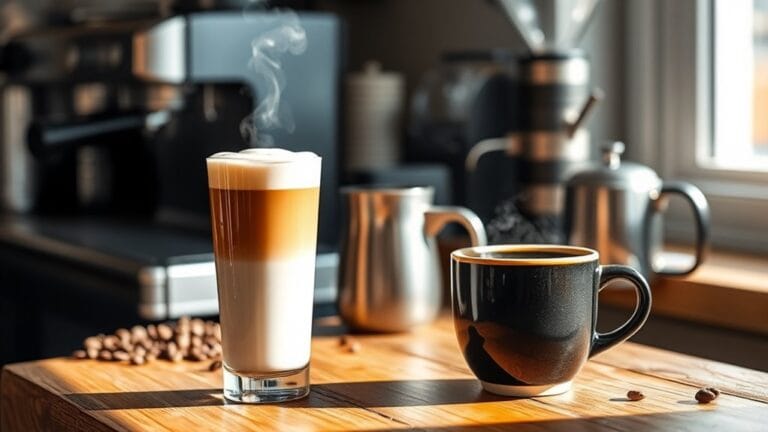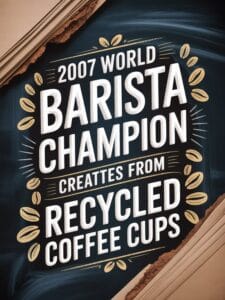Lattes and coffee differ in five main ways. Coffee uses hot water over ground beans, packing bold flavor and roughly 154mg caffeine per 12oz cup, while lattes mix espresso (63mg per shot) with steamed milk and foam, creating a creamy, customizable drink. Coffee relies on simple brewing methods, but lattes need espresso machines and milk-frothing skills. Lattes have more calories (150kcal) from milk, while black coffee is almost calorie-free. Taste-wise, coffee is strong and zesty, lattes are smooth and sweet, like a cozy hug in a mug… more brewing ahead!
Definition and Basic Composition
Coffee and lattes both start with coffee beans, but they quickly split ways.
Coffee, in its simplest form, is just hot water poured over ground beans—bold, straightforward, and free from frills. Additionally, the brewing method affects the overall caffeine content of the drink, making various preparations unique. A typical brewed coffee delivers about 154 mg of caffeine per 12-ounce cup, showcasing its robust nature.
Pure coffee: bold, straightforward brew of hot water and beans—no frills, just rich flavor.
A latte, though, mixes espresso (a strong coffee concentrate) with steamed milk and a dash of foam, creating a creamy, smooth experience. The name “latte” literally means “milk” in Italian, and it lives up to that tag, packing way more milk than your average cup of joe. This preparation method gives lattes less caffeine compared to regular coffee, with one espresso shot containing about 63 mg versus 95 mg in an 8-ounce cup of brewed coffee. While basic coffee screams simplicity, lattes play with texture and extras, like flavored syrups or whipped cream.
Both drinks rule cafes worldwide, but one’s a solo act, and the other’s a full band—beans might unite them, but milk and flair set them apart.
Ingredients and Preparation Technique
- Espresso foundation: Lattes start with a concentrated espresso shot, blasted through an espresso machine, while coffee brews slowly via drip, French press, or pour-over.
- Milk magic: Steaming and frothing milk is latte-specific, creating creamy foam; coffee with milk just pours warm milk in, no fancy tools needed. Coffee with milk served in wide-rimmed mugs maximizes aroma appreciation, an aspect lattes forgo for their artful presentations. The French press method provides full immersion brewing which enhances flavor extraction in coffee.
- Ratio rules: Lattes go heavy on milk (2:1 milk-to-espresso), making them silkier; coffee with milk often balances 1:1 for lighter texture.
- Gear game: Espresso machines and steam wands are latte essentials; coffee needs basic brewers—pick your freedom fighter!
Both drinks dance around flavors and flair, but lattes? They’re the overachievers with extra steps and style.
Caffeine Content Differences

Brewing up a buzz? A latte’s caffeine depends on espresso shots—one shot packs 64-68 mg, while a 16 oz latte (two shots) jumps to ~173 mg. Brewed coffee? An 8 oz cup zings with 95-140 mg, often out-caffeinating lattes because milk dilutes espresso. But double-shot lattes can rival drip coffee’s kick! Beans matter too: robusta beans pack twice the caffeine of arabica, and light roasts edge out dark roasts. Blonde roast coffee averages about 95mg of caffeine per 8-ounce cup, contributing to its reputation for higher caffeine content. Brewing style also plays—espresso machines squeeze more caffeine per ounce than a French press. Milk’s volume makes lattes feel milder, even with similar caffeine, and sipping slowly delays the buzz. Coffee’s bitter punch? Lattes cloak it with creamy smoothness. Choose your weapon: milk-mellowed latte or full-throttle black coffee—caffeine’s sneaky like that! Ultimately, robusta coffee’s caffeine content contributes to the unique flavor profiles and variations in caffeine levels between different coffee beverages.
Caloric and Nutritional Content
Thinking about your morning drink? Caloric and nutritional differences between black coffee and lattes vary widely, making choices pivotal for health goals or dietary freedom.
- Calorie bomb vs. simplicity: A 12 oz latte packs ≈150 kcal (up to 420 kcal for breve!), while black coffee has ≈2 kcal. Additionally, the caloric values of flavored variations, like mocha, can significantly exceed those of standard beverages, with a tall mocha containing 290 calories at Starbucks.
- Fat facts: Lattes with 2% milk contain ≈7g fat, but breve’s half-and-half rockets to 37g. Black coffee? Zero fat unless dressed up.
- Protein perks: Lattes deliver 6–7g protein (milk-based), breve edges to 8g. Black coffee? Nada, unless milk joins the party.
- Diet-friendly tweaks: Swap dairy for almond or oat milk to slash calories/fat—ideal for weight goals. Breve suits keto fans, lattes fit flexible lifestyles. Additionally, exploring local community recommendations can reveal unique coffee options tailored to personal preferences.
Choose freely: tweak portions, milks, or extras to match cravings, energy needs, or even nap math (breve = dessert in disguise).
Taste and Texture Profiles

From counting calories to savoring sips, the experience of drinking coffee versus lattes shifts from numbers to senses.
Lattes wrap espresso in a cozy blanket of steamed milk, creating mild, creamy sips with a caramel-like sweetness. The milk’s sugars soften espresso’s edge, leaving mellow, barely-there bitterness.
Black coffee, though? It’s bold and zesty, bursting with fruity, nutty, or smoky flavors that punch through without milk’s cushion.
Texture seals the deal: lattes feel velvety-smooth, topped with airy foam that dissolves like a cloud, while brewed coffee flows thin and crisp, like water with attitude.
Want comfort? Latte. Crave raw bean power? Coffee. One whispers sweetness, the other roasts loudly—both thrill taste buds differently.
Frequently Asked Questions
Which Is Better for Morning vs. Afternoon Consumption?
Morning consumption favors coffee’s bold flavor and higher caffeine for energy. Afternoon intake leans toward lattes’ milder caffeine levels and creaminess, balancing sustained energy without overstimulation, aligning with personal dietary and sleep priorities.
How Does Environmental Impact Differ Between Lattes and Coffee?
Do sustainability concerns alter beverage preferences? Lattes have higher carbon emissions and water usage due to milk production and processing, contrasting with coffee’s lower footprint. Land use and waste amplify lattes’ environmental impact compared to black coffee.
Can Latte Art Techniques Apply to Regular Coffee?
Latte art techniques rely on espresso crema to anchor microfoam, creating contrast. Regular coffee’s watery surface lacks sufficient texture and stability, preventing defined designs. Milk disperses rapidly, yielding faint or ephemeral patterns compared to espresso-based lattes.
Are Lattes or Coffee More Popular Globally?
Traditional coffee consumption dominates globally with 2.25 billion daily cups, driven by home preparation. While lattes gain traction in specialty markets, their popularity remains concentrated in urban areas and younger demographics preferring premium experiences.
Which Requires Less Equipment for Home Preparation?
Preparing regular coffee requires minimal equipment—hot water, grounds, and basic tools like a drip machine or pour-over setup. Lattes demand an espresso machine and milk-frothing accessories, increasing cost and complexity for home preparation.
References
- https://majestycoffee.com/blogs/posts/coffee-with-milk-vs-latte
- https://aerialresupplycoffee.com/blogs/the-resupply-blog/coffee-vs-latte-understanding-the-differences
- https://www.brewavenuecoffee.com/latte-vs-coffee-exploring-the-differences-between-caffeine-choices/
- https://www.dolce-gusto.ie/world-of-coffee/differences-between-coffees
- https://www.nescafe.com/in/coffee-culture/knowledge/latte
- https://mountainprovincecoffee.com/difference-between-coffee-and-latte/
- https://www.coffeebean.com/blogs/blog/cappuccino-vs-latte-whats-the-difference
- https://www.deathwishcoffee.com/blogs/coffee-talk/what-is-a-latte-here-s-what-you-need-to-know
- https://methodicalcoffee.com/blogs/coffee-culture/cappuccino-vs-latte-vs-macchiato
- https://www.scanomat.com/amokka/guides/know-your-coffee-types-the-great-coffee-guide/





